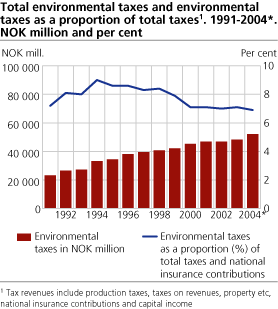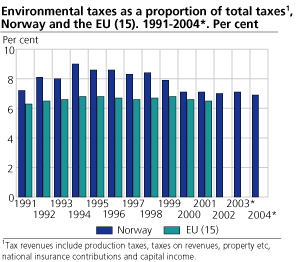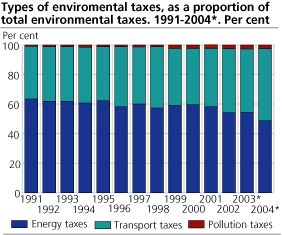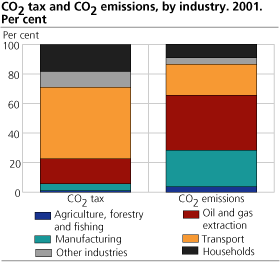Environmental taxes in Norway
Environmental taxes in Norway 1991-2004
Published:
The proportion of tax revenues arising from environmental taxes has been on a downward trend in recent years, despite the fact that such taxes have been on a steady increase since 1991. In 2004, revenues from environmental taxes amounted to NOK 52 billion and accounted for 6.9 per cent of total tax revenues. However, various exemptions mean that it is not always the polluter who bears the brunt of environmental taxes.
In addition to environmental legislation, environmental taxes can be an important environmental policy tool. Environmental taxes are market-based instruments aimed at internalising external environmental costs, thereby stimulating both producers and consumers towards limiting environmental pressure and towards responsible use of natural resources (Eurostat, 2003). In the real world, however, such taxes are weighted against other political priorities such as the competitiveness of industries, employment and regional interests. This leads to various types of exemptions, which means that it is not always the polluter who pays the most.
|
Definition of environmental tax
Statistics Norway uses the OECD/Eurostat definition of environmental tax: "A tax whose tax base is a physical unit (or a proxy of it) of something that has a proven, specific negative impact on the environment." (Eurostat, 2001).
In other words, what is being taxed and not the explicit motivation for the tax, determines whether the tax is considered an environmental tax or not. This means that the purpose of the tax can be something other than environmental protection, yet it can still be classified as an environmental tax (for example, the annual vehicle tax). The figures presented here only include environmental taxes defined as "taxes" in the national accounts. They do not include charges that are fees or part of deposit schemes. |
Decrease from 1994
During the period 1991-2004 revenues from environmental taxes increased by 125 per cent (measured in current prices). When measured as a proportion of total tax revenues, environmental taxes were approximately the same level in 2004 as in 1991 - about 7 per cent. In 1994, the proportion of environmental taxes had risen to 9 per cent, which is the highest level in this period. In 1996, the Green Tax Commission in Norway (see box below for further details) presented its proposals for changing the tax system to the advantage of consumers and businesses that are environmentally friendly (NOU, 1996). Since then, the proportion of revenues from environmental taxes has slowly fallen, and in the past few years, been stable around 7 per cent.
|
Green Tax Commission
The government's task for the Green Tax Commission was to outline how economic instruments could be used to redirect the economy in a more environmentally friendly direction. A white paper was presented in 1996. The Commission proposed that the tax system be changed so that the tax burden on employment was reduced and the taxes on environmental damaging activities/consumption increased. This should take place without changing the total pressure of taxes and charges. The principle that the polluter should pay was made explicit. |
No longer higher proportion of environmental taxes than the EU
A comparison of Norway and the EU15 in the period 1991-2001 shows that Norway's proportion of environmental taxes was well above the EU15 average during the majority of the period. In 2000 and 2001, the difference was only 0.5 per cent. The EU15 average remained around 6 and 7 per cent during the whole period. For Norway, on the other hand, the figure was around 7 per cent in the last years of the period, but reached 9 per cent at the beginning of the period.
Energy and transport taxes dominate
Energy and transportation taxes are the most important environmental taxes in terms of raising revenue. In 2004, each of these two tax categories accounted for more than 48 per cent of total environmental taxes. Energy taxes include taxes on energy products used for transportation and stationary purposes. Transportation taxes include taxes on ownership and use of motor vehicles, transportation equipment and related transportation services.
The remaining environmental taxes accounted for almost 3 per cent of total environmental tax revenues, and thus only play a marginal role in terms of total tax revenues. However, these taxes can be an important tool when it comes to limiting various types of environmental pressure (for example beverage containers). Pollution taxes include taxes on measured or estimated amounts of emissions to air and water, solid waste treatment and noise. Resource taxes include taxes on natural resources. Taxes on the extraction of minerals, oil and natural gas, whose purpose is to capture resource rents, are excluded here. Using this classification definition, there are currently no resource taxes in Norway.
As the figure shows, there has been a small but consistent change in the distribution of different types of environmental taxes since 1991. The proportion of energy taxes has fallen (from 63 to 49 per cent), while at the same time the proportion of transportation taxes has increased (from 36 to 49 per cent). The proportion of pollution taxes has more than doubled, but still contribute little to the total revenues.
Not the polluter who pays
A Nordic report on energy taxes (DST, 2003), shows that the tax burden is not evenly distributed between different energy consumers. This phenomenon is observed in all the Nordic 1 countries and is attributable to various types of exemptions and refund schemes for specific industries. The most extreme example is the manufacturing industry, which accounts for 50 per cent of the energy use in the Nordic countries, but only pays about 5 per cent of the energy taxes. The opposite is true for households, which use about 20 per cent of the energy, but pay 50 per cent of the energy taxes.
Below, we present two examples from 2001. The CO 2 example shows the large disparity between the polluters and those who pay environmental taxes, while the petrol example shows an area with consistency between the consumers/polluters and those who pay the environmental taxes.
Heavy polluters benefit from exemptions
The figure clearly shows that the oil and natural gas industry's proportion of total CO 2 taxes is considerably higher than the industry's proportion of total CO 2 emissions. This industry accounted for about 25 per cent of CO 2 emissions, but paid 50 per cent of the CO 2 taxes. The difference is explained both by the fact that a number of industries are exempt from paying the tax or have a lower CO 2 tax rate, while the oil and natural gas industry pays a relatively higher tax rate. Exemptions from this tax are not as widespread as exemptions from energy taxes as a whole.
Another aspect that is highlighted in the Nordic report is the fact that it is often the pollution intensive industries (industries that have high levels of pollution in relation to their value added) that are exempt from paying environmental taxes. This strengthens the mismatch between the industries that pollute and those who pay environmental taxes.
An analysis of petrol consumption and petrol tax payments show that the "polluter pays" principle is true to a much larger extent for this tax. This is due to the fact that there are few exemptions and refund mechanisms for petrol.
1 The report does not cover Iceland.
References :
DST (2003): Energy Taxes in the Nordic Countries - Does the polluter pay ?. Final report to Eurostat by Statistics Denmark.
Eurostat (2003): Environmental Taxes in the European Union 1980 - 2001 . First signs of a relative " green tax shift ". Statistics in focus, Environment and Energy, Theme 8 - 9/2003, Eurostat.
Eurostat (2001): Environmental taxes - A statistical guide . Methods and nomenclatures, Theme 2 - Economy and Finance, Eurostat.
NOU (1996): Grønne skatter - en politikk for bedre miljø og høy sysselsetting . NOU 1996:9. (Only in Norwegian).
Tables:
Contact
-
Statistics Norway's Information Centre





